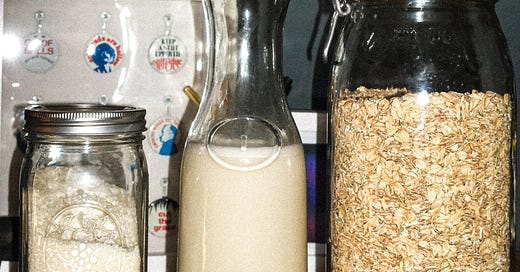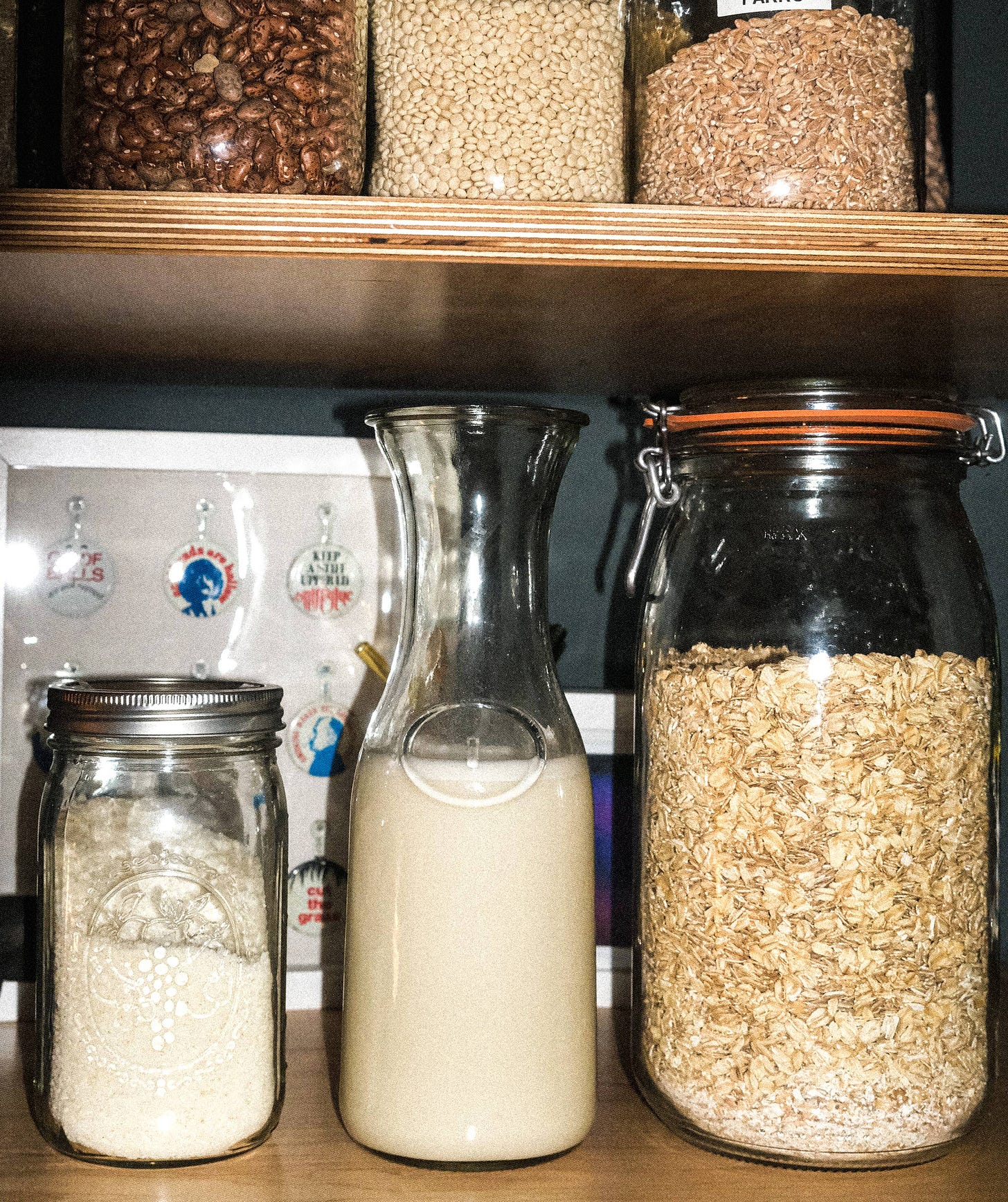I am not scared of cow’s milk.
I come from a long line of Dutch dairy farmers; if anyone were to have the dairy gene, it’s me. I can drink a tall glass of cold, whole milk and only wince once. There are usually bottles of milk in my fridge for yogurt-making, and I will contend that a tablespoon of half-and-half in drip coffee really is sublime. I also, unfortunately, have the unstylish habit of drinking half a glass of milk with a meal—breakfast, typically.
All the same, I haven’t eaten meat since I was a teenager, and while I’ve never gone vegan, I’ve experimented with plant-based dairy alternatives where I could—nut milks, vegan butter spreads that are really just margarine, et cetera. For years I favored soy, then unsweetened almond, and now, as anyone who has entered a coffee shop in the past three years will know, oat.
I make my own oat milk because I am, I guess, scared of plastic, and the plastic-lined paper cartons in the “recycling” bin were taunting me. I, too, read the possibly dubious blog posts about how a popular oat milk brand might be converting starches into sugar in its manufacturing process. I nodded through them even though I was homeschooled and don’t know a thing about science.
The first oat-y waters I made from googled recipes disappointed, they were either chalky or bland or too thin. I set out on my own, even though I wasn’t sure I was going to discover anything that the nice ladies with the SEO food blogs don’t already know. I experimented—more water, soaked nuts, more salt, less sugar, longer blend times. I stopped to consider the elements: fats, sugars, salt, how to quell the viscous nature of the oat.
One promising recipe I tried called for cashews and shredded coconut. The cashews were expensive and discarding their used-up pulp felt wasteful, but the coconut gave the milk a creaminess and an (appropriately subtle) layer of sweetness that the oats couldn’t bring on their own.
Weeks later, lying in bed, it occurred to me that, like raw nuts and seeds, what my oats needed was toastiness. I toasted the oats and the coconut before blending them with water.
The oil was a revelation, too. It seems wrong, I agree, to drink oil, but emulsified, it provides the weight and fat that a milk wants to have. I used avocado oil because it’s allegedly healthier than canola or grapeseed.
After many months tinkering with my final creation, I was satisfied with the ratios, the oil, and the coconut. It doesn’t taste exactly like the stuff at the coffee shop, but it’s not bad, and most important, it’s homemade, relatively simple, and free of single-use plastic.
Here is my recipe:
Not-Bad Creamy Homemade Oat Milk
Oat milk is particular. It doesn’t heat well—think about oatmeal right before you pull it off the burner, thick and gummy—and in the fridge, it will separate within hours. You will probably try to blend it too much, but the cool water and ice cubes will help keep the blender from warming the liquid and causing it to seize up.
Ingredients:
1 cup (115 grams) organic rolled oats
⅓ cup (31 grams) unsweetened shredded coconut
4 cups (945 grams) cold water
1 tablespoon avocado or other neutral oil
1 teaspoon maple syrup
1 or 2 ice cubes
Pinch of kosher salt
Instructions:
Preheat oven to 325℉.
Spread oats and shredded coconut on a small baking sheet and toast for 10 minutes, being careful not to burn the coconut. Let cool completely.
In a high-speed blender, combine the toasted oats and coconut and remaining ingredients. Blend for no longer than 30 to 40 seconds. (Any longer and it will become gooey.)
Strain the blended mixture through either a very fine mesh sieve or a normal sieve lined with cheesecloth.
Refrigerate in an airtight container. Enjoy within four days.
Notes:
You need to use rolled, not steel-cut oats. I would also suggest using organic.
The oil makes the oat milk creamier, but you can omit if preferred. You can also skip the maple syrup.
You don’t need a Vitamix for this. I have this $100 Kitchenaid blender and it works great.
For step 4, I use this yogurt strainer, which I bought for straining homemade yogurt (a different letter, entirely). Compared to cheesecloth, it makes cleanup in the dishwasher easier.
The milk will separate in the fridge, just shake before use. I use this bottle to store.
I still have not discovered an amazing use for the leftover oat pulp other than to freeze it and put it in smoothies, but the recipe makes more pulp than I make smoothies. If you have a great idea, leave it in a comment.
Home Food is edited by Jillian Goodman.




I made this this week for the first time in a quest to reduce waste @ home and it’s decidedly not bad! Thanks for putting in the time to craft this recipe and for sharing it 🙏🏻
As someone who heats oat milk on the stove every morning for her chai, thank you for validating that it truly does not heat well. I use a small whisk while it heats and it ends up being fine, not great. Now that the summer heat is settling into the PNW, I want to try this recipe for iced chais!